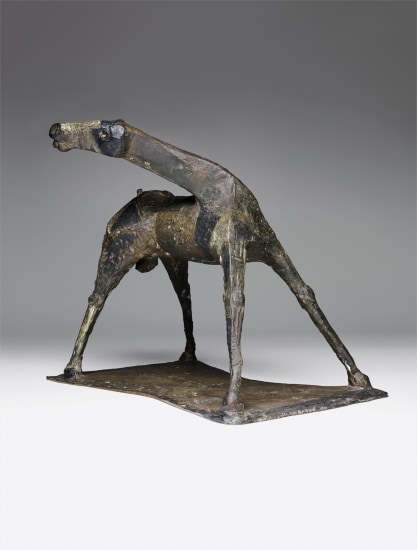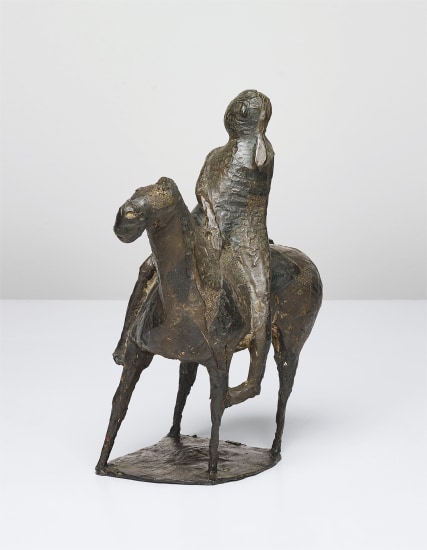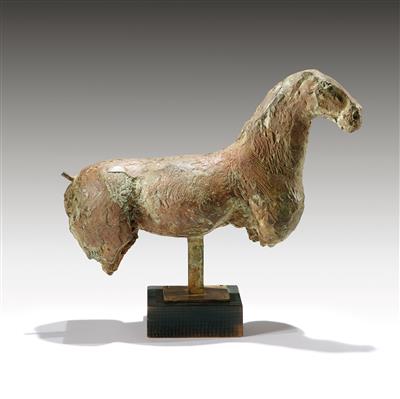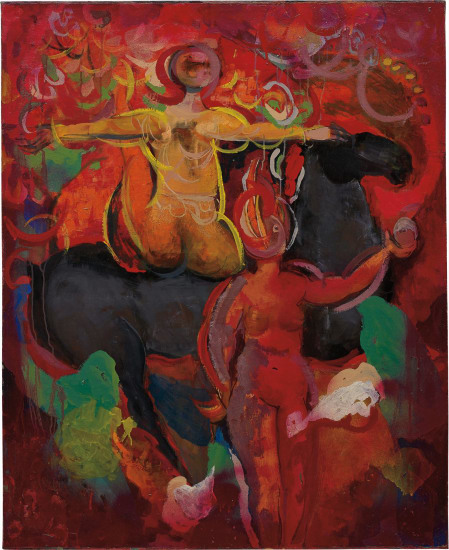PROPERTY FROM A PRIVATE COLLECTION MARINO MARINI (1901-1980) Cavallo e cavaliere signed and dated 'Marino 1951' (lower right) oil on paper laid on canvas 100 x 76.5cm (39 3/8 x 30 1/8in). Painted in 1951 Fußnoten The authenticity of this work has kindly been confirmed by the Fondazione Marino Marini Provenance Dennis Hotz Fine Art Ltd, Johannesburg. Private collection, South Africa (acquired from the above on 11 March 1981). Thence by descent to the present owner. Cavallo e cavaliere is an iconic image, created by one of Italy's most celebrated twentieth century artists. Marino Marini focused on just a few select motifs throughout his 65-year career as an artist, of which the horse and rider is foremost. Fascinated from an early age by nature, history and his Etruscan heritage, Marini sought to revisit classical imagery through the modern aesthetic of his era, standing apart from the concerns of his contemporaries. His paintings and sculptures, simple in their format, are bursting with energy and charisma. After studying at the Florentine Academy of Fine Arts, Marini visited Paris frequently in the 1930s where he met many of the great names of European art of the time: Pablo Picasso Georges Braque Wassily Kandinsky and other contemporary Italian artists such as Massimo Campigli Giorgio de Chirico and Alberto Magnelli Much preferring solitude however, Marini often travelled alone and would explore northern Europe, wholly immersing himself in native cultures to develop his understanding of foreign civilisations, whilst cultivating and widening his appreciation for style and subject. The great tradition of Marini's homeland proved enormously influential in the artist's subject and method as he looked back to the lives of his Italian ancestors: 'if you really want to find the sources of my present style in antiquity, I must confess that you will find them in the remains of the life of the past rather than in those of its art. The fossilized corpses that have been unearthed in Pompeii' (Marini quoted in E. Roditi, Dialogues – Conversations with European Artists at Mid-Century, London, 1990, p. 87). Marini's earlier works echoed Etruscan portraiture, both sculpted and painted, whilst archaeological excavations of the 1930s and the cave paintings of Northern Europe, potentially seen by the artist on his extensive travels through the region, certainly find echoes in the simplified forms of his oeuvre. The motif of the horse and rider has been depicted by artists for centuries, long considered as the archetypal partnership of authority and power. Stoic figures on horseback, from Alexander the Great with Bucephalus to Napoleon and Marengo, hold a prestigious place in history and art history. In Cavallo e cavaliere however, the power of the man is seemingly diminished: 'to the horse [Marini] now restores its ancient significance as a fertilizing force. The rider – naked, plump, unseeing, witless, arms outflung or upraised, wobbling ever more precariously – is the man of today, signifying the opposite' (H. Read, P. Waldberg & G. di San Lazzaro, Marino Marini Complete Works, Milan, 1970, p. 187). Whilst Marini may have distanced himself from the mechanical and industrial advances that the Second Wave Futurists were celebrating at the time, the instability of his riders and horses surely reflect his contemporary, post-war landscape. Marini had witnessed a highly charged fascist Italian government ally itself with Nazi ideology and watched the world tumble into a second world war. Furthermore, he had been sensitive to the war's terrible consequence on the equestrian figure: his experience of seeing Italian peasants fleeing bombardments on horseback can be seen through the terrified steeds of his post-war works. Marini's escape to Switzerland in 1943 offered him the chance to meet with other contemporary artists, most notably, Alberto Giacometti We can certainly see the influence the artists may have had on one another, especially in t
PROPERTY FROM A PRIVATE COLLECTION MARINO MARINI (1901-1980) Cavallo e cavaliere signed and dated 'Marino 1951' (lower right) oil on paper laid on canvas 100 x 76.5cm (39 3/8 x 30 1/8in). Painted in 1951 Fußnoten The authenticity of this work has kindly been confirmed by the Fondazione Marino Marini Provenance Dennis Hotz Fine Art Ltd, Johannesburg. Private collection, South Africa (acquired from the above on 11 March 1981). Thence by descent to the present owner. Cavallo e cavaliere is an iconic image, created by one of Italy's most celebrated twentieth century artists. Marino Marini focused on just a few select motifs throughout his 65-year career as an artist, of which the horse and rider is foremost. Fascinated from an early age by nature, history and his Etruscan heritage, Marini sought to revisit classical imagery through the modern aesthetic of his era, standing apart from the concerns of his contemporaries. His paintings and sculptures, simple in their format, are bursting with energy and charisma. After studying at the Florentine Academy of Fine Arts, Marini visited Paris frequently in the 1930s where he met many of the great names of European art of the time: Pablo Picasso Georges Braque Wassily Kandinsky and other contemporary Italian artists such as Massimo Campigli Giorgio de Chirico and Alberto Magnelli Much preferring solitude however, Marini often travelled alone and would explore northern Europe, wholly immersing himself in native cultures to develop his understanding of foreign civilisations, whilst cultivating and widening his appreciation for style and subject. The great tradition of Marini's homeland proved enormously influential in the artist's subject and method as he looked back to the lives of his Italian ancestors: 'if you really want to find the sources of my present style in antiquity, I must confess that you will find them in the remains of the life of the past rather than in those of its art. The fossilized corpses that have been unearthed in Pompeii' (Marini quoted in E. Roditi, Dialogues – Conversations with European Artists at Mid-Century, London, 1990, p. 87). Marini's earlier works echoed Etruscan portraiture, both sculpted and painted, whilst archaeological excavations of the 1930s and the cave paintings of Northern Europe, potentially seen by the artist on his extensive travels through the region, certainly find echoes in the simplified forms of his oeuvre. The motif of the horse and rider has been depicted by artists for centuries, long considered as the archetypal partnership of authority and power. Stoic figures on horseback, from Alexander the Great with Bucephalus to Napoleon and Marengo, hold a prestigious place in history and art history. In Cavallo e cavaliere however, the power of the man is seemingly diminished: 'to the horse [Marini] now restores its ancient significance as a fertilizing force. The rider – naked, plump, unseeing, witless, arms outflung or upraised, wobbling ever more precariously – is the man of today, signifying the opposite' (H. Read, P. Waldberg & G. di San Lazzaro, Marino Marini Complete Works, Milan, 1970, p. 187). Whilst Marini may have distanced himself from the mechanical and industrial advances that the Second Wave Futurists were celebrating at the time, the instability of his riders and horses surely reflect his contemporary, post-war landscape. Marini had witnessed a highly charged fascist Italian government ally itself with Nazi ideology and watched the world tumble into a second world war. Furthermore, he had been sensitive to the war's terrible consequence on the equestrian figure: his experience of seeing Italian peasants fleeing bombardments on horseback can be seen through the terrified steeds of his post-war works. Marini's escape to Switzerland in 1943 offered him the chance to meet with other contemporary artists, most notably, Alberto Giacometti We can certainly see the influence the artists may have had on one another, especially in t






.jpg)

.jpg)

.jpg)
.jpg)


Testen Sie LotSearch und seine Premium-Features 7 Tage - ohne Kosten!
Lassen Sie sich automatisch über neue Objekte in kommenden Auktionen benachrichtigen.
Suchauftrag anlegen